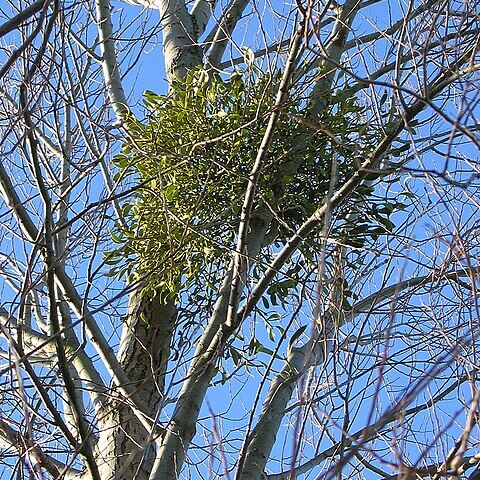Aerial stem-parasitic shrubs, glabrous, monoecious or (not in Malesia) dioecious. Stems much-branched; internodes terete or compressed or flattened decussately, often longitudinally ridged or striate. Leaves opposite, normally developed or rudimentary; normally developed leaves entire, unifacial, curvinerved, usually with 3 or 5 veins visible; rudimentary leaves bract-like, c. 1 mm long. Inflorescences terminal or axillary, basically a 3-flowered cymule, sometimes reduced to 1 flower or enlarged by development of adventitious flowers; bracts small, triangular, in pairs forming a boat-shaped cupule subtending each cymule. Male flowers flattened, 0.5-1.5 mm long, 4-merous; tepals triangular, valvate; anthers disc-shaped, many-loculate, opening by pores, sessile and fused to the tepal. Female flowers cylindric, at anthesis usually less than 2 mm long, 4-merous; tepals triangular; stigma small, nipple-shaped. Fruit narrow-ellipsoid to globose, smooth or tuberculate; tepals usually caducous, rarely persistent as a crown on the fruit. Fig. 9. Fig. 10. Fig. 11. Fig. 12. Fig. 13.
Shrubs parasitic, monoecious or dioecious. Branches opposite, dichotomous, or verticillate; internodes terete or flattened with successive internodes at right angles to each other. Leaves well developed or reduced to scales. Inflorescences axillary or terminal, 1-7-flowered cymes; peduncle short to nearly absent; bracts in pairs, connate, boatlike, forming a navicular involucre, or 1 or 2 beneath each flower. Pedicel absent. Male flower ovoid or ellipsoid in mature bud; perianth lobes usually 4. Anthers sessile, adnate to perianth lobes, rarely connate into synandrium, rotund or elliptic, multiloculed, dehiscence by numerous pores. Pollen grains subspheric to prolate, trilobate-circular in cross section. Female flower ovoid to ellipsoid in mature bud; perianth lobes (3 or)4, usually deciduous. Placentation basal. Style short or absent; stigma nipple-shaped or cushion-shaped. Berry globose, ovoid, or ellipsoid, exocarp smooth or verrucose, indehiscent, usually dispersed by birds.
Shrubs [herbs], dioecious [monoecious]; parasitic on branches of woody angiosperms and gymnosperms, infections localized. Stems single or multiple; branching pseudodichotomous [percurrent]. Leaves well developed [scalelike]. Inflorescences axillary or terminal, dichasial cymes. Staminate flowers: petals (3–)4(–6), triangular, distinct; stamens (3–)4(–6); anthers multilocular, dehiscing by numerous pores; nectary absent. Pistillate flowers: petals (3–)4(–6), triangular, distinct; ovary 0-locular; style absent [short-conic]; stigma poorly differentiated [capitate]. Berries sessile in bracteal cup [pedicel present, not recurved], not explosively dehiscent, 1-colored, smooth [warty], scars of petal remnants at apex. Seeds mucilaginous when removed from fruit, endosperm slightly flattened, ovate to elliptic in broadest outline; embryo oriented transversely. x = 14.
Glabrous shrubs, erect or pendulous. Internodes terete or successively flattened alternately, ridged or furrowed longitudinally. Leaves present or apparently absent (reduced to small scales). Inflorescence axillary or (not in Australia) terminal, a sessile or pedunculate cyme of 3 (1-5) flowers subtended by a boat-shaped pair of bracts. Plants monoecious or (not in Australia) dioecious, when monoecious with either male or female flowers central in the cymes. Male flower 2-4-merous, with an ovoid anther sessile on each tepal; anthers many-locular. Female flower 2-4-merous; tepals caducous after anthesis. Fruit globular or ellipsoidal, smooth or warty; stigma persistent as a very small nipple at apex.
Shrubby plants (rarely minute herbs), parasitic on dicotyledons (rarely gymnosperms), glabrous, monoecious or dioecious; branching usually dense and intricate, forked or whorled; internodes rounded or compressed, sometimes ribbed and twisted 90° to form a decussate leaf and branching pattern.
Inflorescence a typical or modified dichasium subtended by a pair of usually fused bracts (bracteal cup); dichasia sessile or peduncled, solitary or fascicled, axillary or axillary and terminal.
Dioecious plants with staminate dichasia most commonly bearing (2)3 flowers; pistillate dichasia with mostly a solitary flower in the bracteal cup.
Monoecious plants with central flower usually staminate and lateral ones pistillate, or with all flowers of the dichasium staminate or pistillate.
Berries white, yellow, orange or red, smooth or warty, pedicelled or sessile in the bracteal cup; style and/or stigma usually persistent in fruit.
Pistillate flowers 3–4-merous; style present or absent; stigma sometimes expanded.
Staminate flowers 3–4-merous; anthers dehiscing by numerous pores.

